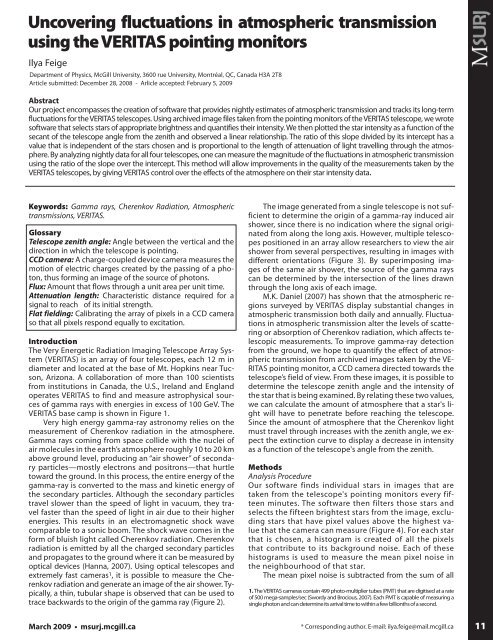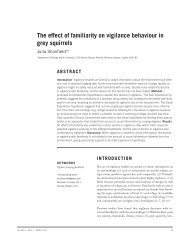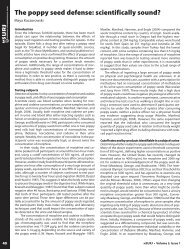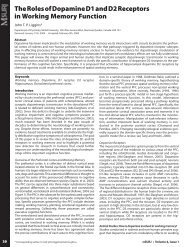the entire issue - McGill Science Undergraduate Research Journal ...
the entire issue - McGill Science Undergraduate Research Journal ...
the entire issue - McGill Science Undergraduate Research Journal ...
Create successful ePaper yourself
Turn your PDF publications into a flip-book with our unique Google optimized e-Paper software.
Uncovering fluctuations in atmospheric transmission<br />
using <strong>the</strong> VERITAS pointing monitors<br />
Ilya Feige<br />
Department of Physics, <strong>McGill</strong> University, 3600 rue University, Montréal, QC, Canada H3A 2T8<br />
Article submitted: December 28, 2008 - Arlicle accepted: February 5, 2009<br />
Abstract<br />
Our project encompasses <strong>the</strong> creation of software that provides nightly estimates of atmospheric transmission and tracks its long-term<br />
fluctuations for <strong>the</strong> VERITAS telescopes. Using archived image files taken from <strong>the</strong> pointing monitors of <strong>the</strong> VERITAS telescope, we wrote<br />
software that selects stars of appropriate brightness and quantifies <strong>the</strong>ir intensity. We <strong>the</strong>n plotted <strong>the</strong> star intensity as a function of <strong>the</strong><br />
secant of <strong>the</strong> telescope angle from <strong>the</strong> zenith and observed a linear relationship. The ratio of this slope divided by its intercept has a<br />
value that is independent of <strong>the</strong> stars chosen and is proportional to <strong>the</strong> length of attenuation of light travelling through <strong>the</strong> atmosphere.<br />
By analyzing nightly data for all four telescopes, one can measure <strong>the</strong> magnitude of <strong>the</strong> fluctuations in atmospheric transmission<br />
using <strong>the</strong> ratio of <strong>the</strong> slope over <strong>the</strong> intercept. This method will allow improvements in <strong>the</strong> quality of <strong>the</strong> measurements taken by <strong>the</strong><br />
VERITAS telescopes, by giving VERITAS control over <strong>the</strong> effects of <strong>the</strong> atmosphere on <strong>the</strong>ir star intensity data.<br />
Keywords: Gamma rays, Cherenkov Radiation, Atmospheric<br />
transmissions, VERITAS.<br />
Glossary<br />
Telescope zenith angle: Angle between <strong>the</strong> vertical and <strong>the</strong><br />
direction in which <strong>the</strong> telescope is pointing.<br />
CCD camera: A charge-coupled device camera measures <strong>the</strong><br />
motion of electric charges created by <strong>the</strong> passing of a photon,<br />
thus forming an image of <strong>the</strong> source of photons.<br />
Flux: Amount that flows through a unit area per unit time.<br />
Attenuation length: Characteristic distance required for a<br />
signal to reach of its initial strength.<br />
Flat fielding: Calibrating <strong>the</strong> array of pixels in a CCD camera<br />
so that all pixels respond equally to excitation.<br />
Introduction<br />
The Very Energetic Radiation Imaging Telescope Array System<br />
(VERITAS) is an array of four telescopes, each 12 m in<br />
diameter and located at <strong>the</strong> base of Mt. Hopkins near Tucson,<br />
Arizona. A collaboration of more than 100 scientists<br />
from institutions in Canada, <strong>the</strong> U.S., Ireland and England<br />
operates VERITAS to find and measure astrophysical sources<br />
of gamma rays with energies in excess of 100 GeV. The<br />
VERITAS base camp is shown in Figure 1.<br />
Very high energy gamma-ray astronomy relies on <strong>the</strong><br />
measurement of Cherenkov radiation in <strong>the</strong> atmosphere.<br />
Gamma rays coming from space collide with <strong>the</strong> nuclei of<br />
air molecules in <strong>the</strong> earth’s atmosphere roughly 10 to 20 km<br />
above ground level, producing an “air shower” of secondary<br />
particles—mostly electrons and positrons—that hurtle<br />
toward <strong>the</strong> ground. In this process, <strong>the</strong> <strong>entire</strong> energy of <strong>the</strong><br />
gamma-ray is converted to <strong>the</strong> mass and kinetic energy of<br />
<strong>the</strong> secondary particles. Although <strong>the</strong> secondary particles<br />
travel slower than <strong>the</strong> speed of light in vacuum, <strong>the</strong>y travel<br />
faster than <strong>the</strong> speed of light in air due to <strong>the</strong>ir higher<br />
energies. This results in an electromagnetic shock wave<br />
comparable to a sonic boom. The shock wave comes in <strong>the</strong><br />
form of bluish light called Cherenkov radiation. Cherenkov<br />
radiation is emitted by all <strong>the</strong> charged secondary particles<br />
and propagates to <strong>the</strong> ground where it can be measured by<br />
optical devices (Hanna, 2007). Using optical telescopes and<br />
extremely fast cameras 1 , it is possible to measure <strong>the</strong> Cherenkov<br />
radiation and generate an image of <strong>the</strong> air shower. Typically,<br />
a thin, tubular shape is observed that can be used to<br />
trace backwards to <strong>the</strong> origin of <strong>the</strong> gamma ray (Figure 2).<br />
March 2009 • msurj.mcgill.ca<br />
The image generated from a single telescope is not sufficient<br />
to determine <strong>the</strong> origin of a gamma-ray induced air<br />
shower, since <strong>the</strong>re is no indication where <strong>the</strong> signal originated<br />
from along <strong>the</strong> long axis. However, multiple telescopes<br />
positioned in an array allow researchers to view <strong>the</strong> air<br />
shower from several perspectives, resulting in images with<br />
different orientations (Figure 3). By superimposing images<br />
of <strong>the</strong> same air shower, <strong>the</strong> source of <strong>the</strong> gamma rays<br />
can be determined by <strong>the</strong> intersection of <strong>the</strong> lines drawn<br />
through <strong>the</strong> long axis of each image.<br />
M.K. Daniel (2007) has shown that <strong>the</strong> atmospheric regions<br />
surveyed by VERITAS display substantial changes in<br />
atmospheric transmission both daily and annually. Fluctuations<br />
in atmospheric transmission alter <strong>the</strong> levels of scattering<br />
or absorption of Cherenkov radiation, which affects telescopic<br />
measurements. To improve gamma-ray detection<br />
from <strong>the</strong> ground, we hope to quantify <strong>the</strong> effect of atmospheric<br />
transmission from archived images taken by <strong>the</strong> VE-<br />
RITAS pointing monitor, a CCD camera directed towards <strong>the</strong><br />
telescope’s field of view. From <strong>the</strong>se images, it is possible to<br />
determine <strong>the</strong> telescope zenith angle and <strong>the</strong> intensity of<br />
<strong>the</strong> star that is being examined. By relating <strong>the</strong>se two values,<br />
we can calculate <strong>the</strong> amount of atmosphere that a star's light<br />
will have to penetrate before reaching <strong>the</strong> telescope.<br />
Since <strong>the</strong> amount of atmosphere that <strong>the</strong> Cherenkov light<br />
must travel through increases with <strong>the</strong> zenith angle, we expect<br />
<strong>the</strong> extinction curve to display a decrease in intensity<br />
as a function of <strong>the</strong> telescope's angle from <strong>the</strong> zenith.<br />
Methods<br />
Analysis Procedure<br />
Our software finds individual stars in images that are<br />
taken from <strong>the</strong> telescope's pointing monitors every fifteen<br />
minutes. The software <strong>the</strong>n filters those stars and<br />
selects <strong>the</strong> fifteen brightest stars from <strong>the</strong> image, excluding<br />
stars that have pixel values above <strong>the</strong> highest value<br />
that <strong>the</strong> camera can measure (Figure 4). For each star<br />
that is chosen, a histogram is created of all <strong>the</strong> pixels<br />
that contribute to its background noise. Each of <strong>the</strong>se<br />
histograms is used to measure <strong>the</strong> mean pixel noise in<br />
<strong>the</strong> neighbourhood of that star.<br />
The mean pixel noise is subtracted from <strong>the</strong> sum of all<br />
1. The VERITAS cameras contain 499 photo-multiplier tubes (PMT) that are digitised at a rate<br />
of 500 mega-samples/sec (Swordy and Brocious, 2007). Each PMT is capable of measuring a<br />
single photon and can determine its arrival time to within a few billionths of a second.<br />
* Corresponding author. E-mail: ilya.feige@mail.mcgill.ca<br />
11









